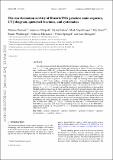Notice
This is not the latest version of this item. The latest version can be found at:https://dspace.mit.edu/handle/1721.1/132560.2
The star formation activity of IllustrisTNG galaxies: main sequence, UVJ diagram, quenched fractions, and systematics
| dc.contributor.author | Donnari, Martina | |
| dc.contributor.author | Pillepich, Annalisa | |
| dc.contributor.author | Nelson, Dylan | |
| dc.contributor.author | Vogelsberger, Mark | |
| dc.contributor.author | Genel, Shy | |
| dc.contributor.author | Weinberger, Rainer | |
| dc.contributor.author | Marinacci, Federico | |
| dc.contributor.author | Springel, Volker | |
| dc.contributor.author | Hernquist, Lars | |
| dc.date.accessioned | 2021-09-20T18:23:02Z | |
| dc.date.available | 2021-09-20T18:23:02Z | |
| dc.identifier.uri | https://hdl.handle.net/1721.1/132560 | |
| dc.description.abstract | © 2019 The Author(s). We select galaxies from the IllustrisTNG hydrodynamical simulations (Mstars109Mo at 0 ≤ z ≤ 2) and characterize the shapes and evolutions of their UVJ and star formation rate Cstellar mass (SFR-CMstars) diagrams. We quantify the systematic uncertainties related to different criteria to classify star-forming versus quiescent galaxies, different SFR estimates, and by accounting for the star formation measured within different physical apertures. The TNG model returns the observed features of the UVJ diagram at z ≤ 2, with a clear separation between two classes of galaxies. It also returns a tight star-forming main sequence (MS) for Mstars < 1010.5 (Mo) with a ∼0.3 dex scatter at z ∼ 0 in our fiducial choices. If a UVJbased cut is adopted, the TNG MS exhibits a downwardly bending at stellar masses of about 1010.5-10.7 Mo. Moreover, the model predicts that ∼80 (50) per cent of 1010.5-11Mo galaxies at z = 0 (z = 2) are quiescent and the numbers of quenched galaxies at intermediate redshifts and high masses are in better agreement with observational estimates than previous models. However, shorter SFR-averaging time-scales imply higher normalizations and scatter of the MS, while smaller apertures lead to underestimating the galaxy SFRs: Overall we estimate the inspected systematic uncertainties to sum up to about 0.2.0.3 dex in the locus of the MS and to about 15 percentage points in the fraction of quenched galaxies. While TNG colour distributions are clearly bimodal, this is not the case for the SFR logarithmic distributions in bins of stellar mass (SFR ≥ 10.3 Moy-1). Finally, the slope and z = 0 normalization of the TNG MS are consistent with observational findings; however, the locus of the TNG MS remains lower by about 0.2.0.5 dex at 0.75 ≤z <2 than the available observational estimates taken at face value. | en_US |
| dc.language.iso | en | |
| dc.publisher | Oxford University Press (OUP) | en_US |
| dc.relation.isversionof | 10.1093/MNRAS/STZ712 | en_US |
| dc.rights | Creative Commons Attribution-Noncommercial-Share Alike | en_US |
| dc.rights.uri | http://creativecommons.org/licenses/by-nc-sa/4.0/ | en_US |
| dc.source | arXiv | en_US |
| dc.title | The star formation activity of IllustrisTNG galaxies: main sequence, UVJ diagram, quenched fractions, and systematics | en_US |
| dc.type | Article | en_US |
| dc.relation.journal | Monthly Notices of the Royal Astronomical Society | en_US |
| dc.eprint.version | Author's final manuscript | en_US |
| dc.type.uri | http://purl.org/eprint/type/JournalArticle | en_US |
| eprint.status | http://purl.org/eprint/status/PeerReviewed | en_US |
| dc.date.updated | 2020-11-17T14:47:31Z | |
| dspace.orderedauthors | Donnari, M; Pillepich, A; Nelson, D; Vogelsberger, M; Genel, S; Weinberger, R; Marinacci, F; Springel, V; Hernquist, L | en_US |
| dspace.date.submission | 2020-11-17T14:47:39Z | |
| mit.journal.volume | 485 | en_US |
| mit.journal.issue | 4 | en_US |
| mit.license | OPEN_ACCESS_POLICY | |
| mit.metadata.status | Authority Work and Publication Information Needed |
